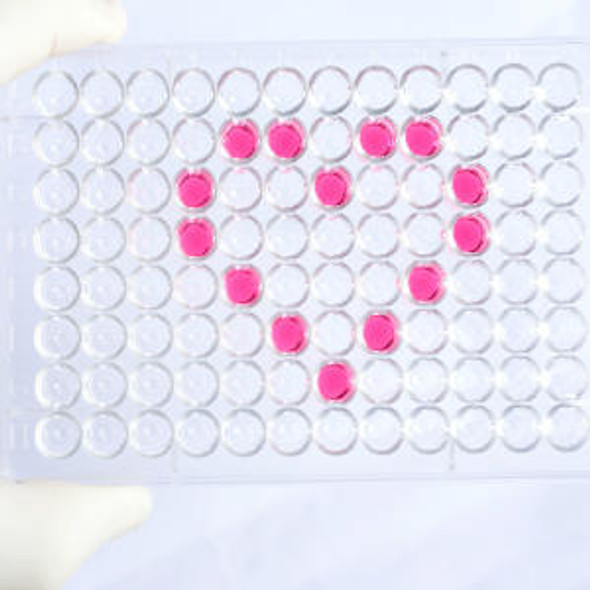Rat Cell Biology ELISA Kits 1
Rat 60 kDa heat shock protein, mitochondrial (Hspd1) ELISA Kit
- SKU:
- RTEB0470
- Product Type:
- ELISA Kit
- Size:
- 96 Assays
- Uniprot:
- P63039
- Range:
- 0.156-10 ng/mL
- ELISA Type:
- Sandwich
- Synonyms:
- HSP-60, HSPD1, Heat Shock Protein 60
- Reactivity:
- Rat
Description
| Product Name: | Rat 60 kDa heat shock protein, mitochondrial (Hspd1) ELISA Kit |
| Product Code: | RTEB0470 |
| Alias: | 60 kDa heat shock protein, mitochondrial, 60 kDa chaperonin, Chaperonin 60, CPN60, HSP-65, Heat shock protein 60, HSP-60, Hsp60, Mitochondrial matrix protein P1, Hspd1, Hsp60 |
| Uniprot: | P63039 |
| Reactivity: | Rat |
| Range: | 0.156-10 ng/mL |
| Detection Method: | Sandwich |
| Size: | 96 Assay |
| Storage: | Please see kit components below for exact storage details |
| Note: | For research use only |
| UniProt Protein Function: | HSP60: Implicated in mitochondrial protein import and macromolecular assembly. May facilitate the correct folding of imported proteins. May also prevent misfolding and promote the refolding and proper assembly of unfolded polypeptides generated under stress conditions in the mitochondrial matrix. Interacts with HRAS. Interacts with HBV protein X and HTLV-1 protein p40tax. Belongs to the chaperonin (HSP60) family. |
| UniProt Protein Details: | Protein type:Chaperone; Mitochondrial Cellular Component: Golgi apparatus; extracellular space; protein complex; cell surface; rough endoplasmic reticulum; intracellular membrane-bound organelle; mitochondrion; early endosome; coated pit; cytosol; lipid raft; secretory granule; mitochondrial crista; membrane; mitochondrial matrix; mitochondrial inner membrane; cytoplasm; plasma membrane; lipopolysaccharide receptor complex; cyclin-dependent protein kinase activating kinase holoenzyme complex; myelin sheath Molecular Function:insulin binding; protein binding; protease binding; protein heterodimerization activity; lipopolysaccharide binding; p53 binding; chaperone binding; ubiquitin protein ligase binding; double-stranded RNA binding; protein complex binding; misfolded protein binding; ATP binding Biological Process: B cell proliferation; T cell activation; positive regulation of apoptosis; positive regulation of interleukin-12 production; isotype switching to IgG isotypes; response to lipopolysaccharide; response to organic cyclic substance; positive regulation of interleukin-10 production; response to organic substance; protein refolding; negative regulation of neuron apoptosis; positive regulation of T cell mediated immune response to tumor cell; positive regulation of interferon-alpha production; positive regulation of macrophage activation; caspase activation; response to drug; B cell activation; chaperone cofactor-dependent protein folding; protein stabilization; positive regulation of interleukin-6 production; B cell cytokine production; detection of misfolded protein; response to cocaine; response to unfolded protein; response to ATP; MyD88-dependent toll-like receptor signaling pathway; positive regulation of interferon-gamma production; 'de novo' protein folding; response to hydrogen peroxide; response to estrogen stimulus; response to heat; response to hypoxia; positive regulation of T cell activation; negative regulation of apoptosis; positive regulation of inflammatory response |
| NCBI Summary: | a stress-inducible molecular chaperone which participates in protein folding [RGD, Feb 2006] |
| UniProt Code: | P63039 |
| NCBI GenInfo Identifier: | 51702230 |
| NCBI Gene ID: | 63868 |
| NCBI Accession: | P63039.1 |
| UniProt Secondary Accession: | P63039,P19226, P19227, P97602, |
| UniProt Related Accession: | P63039 |
| Molecular Weight: | 60,955 Da |
| NCBI Full Name: | 60 kDa heat shock protein, mitochondrial |
| NCBI Synonym Full Names: | heat shock protein 1 (chaperonin) |
| NCBI Official Symbol: | Hspd1 |
| NCBI Official Synonym Symbols: | Hsp60; Hspd1-30p |
| NCBI Protein Information: | 60 kDa heat shock protein, mitochondrial; CPN60; HSP-60; HSP-65; chaperonin 60; 60 kDa chaperonin; heat shock 60kDa protein 1; heat shock protein 60 (liver); mitochondrial matrix protein P1; heat shock 60kD protein 1 (chaperonin) |
| UniProt Protein Name: | 60 kDa heat shock protein, mitochondrial |
| UniProt Synonym Protein Names: | 60 kDa chaperonin; Chaperonin 60; CPN60; HSP-65; Heat shock protein 60; HSP-60; Hsp60; Mitochondrial matrix protein P1 |
| Protein Family: | 60 kDa heat shock protein |
| UniProt Gene Name: | Hspd1 |
| UniProt Entry Name: | CH60_RAT |
| Component | Quantity (96 Assays) | Storage |
| ELISA Microplate (Dismountable) | 8×12 strips | -20°C |
| Lyophilized Standard | 2 | -20°C |
| Sample Diluent | 20ml | -20°C |
| Assay Diluent A | 10mL | -20°C |
| Assay Diluent B | 10mL | -20°C |
| Detection Reagent A | 120µL | -20°C |
| Detection Reagent B | 120µL | -20°C |
| Wash Buffer | 30mL | 4°C |
| Substrate | 10mL | 4°C |
| Stop Solution | 10mL | 4°C |
| Plate Sealer | 5 | - |
Other materials and equipment required:
- Microplate reader with 450 nm wavelength filter
- Multichannel Pipette, Pipette, microcentrifuge tubes and disposable pipette tips
- Incubator
- Deionized or distilled water
- Absorbent paper
- Buffer resevoir
*Note: The below protocol is a sample protocol. Protocols are specific to each batch/lot. For the correct instructions please follow the protocol included in your kit.
Allow all reagents to reach room temperature (Please do not dissolve the reagents at 37°C directly). All the reagents should be mixed thoroughly by gently swirling before pipetting. Avoid foaming. Keep appropriate numbers of strips for 1 experiment and remove extra strips from microtiter plate. Removed strips should be resealed and stored at -20°C until the kits expiry date. Prepare all reagents, working standards and samples as directed in the previous sections. Please predict the concentration before assaying. If values for these are not within the range of the standard curve, users must determine the optimal sample dilutions for their experiments. We recommend running all samples in duplicate.
| Step | |
| 1. | Add Sample: Add 100µL of Standard, Blank, or Sample per well. The blank well is added with Sample diluent. Solutions are added to the bottom of micro ELISA plate well, avoid inside wall touching and foaming as possible. Mix it gently. Cover the plate with sealer we provided. Incubate for 120 minutes at 37°C. |
| 2. | Remove the liquid from each well, don't wash. Add 100µL of Detection Reagent A working solution to each well. Cover with the Plate sealer. Gently tap the plate to ensure thorough mixing. Incubate for 1 hour at 37°C. Note: if Detection Reagent A appears cloudy warm to room temperature until solution is uniform. |
| 3. | Aspirate each well and wash, repeating the process three times. Wash by filling each well with Wash Buffer (approximately 400µL) (a squirt bottle, multi-channel pipette,manifold dispenser or automated washer are needed). Complete removal of liquid at each step is essential. After the last wash, completely remove remaining Wash Buffer by aspirating or decanting. Invert the plate and pat it against thick clean absorbent paper. |
| 4. | Add 100µL of Detection Reagent B working solution to each well. Cover with the Plate sealer. Incubate for 60 minutes at 37°C. |
| 5. | Repeat the wash process for five times as conducted in step 3. |
| 6. | Add 90µL of Substrate Solution to each well. Cover with a new Plate sealer and incubate for 10-20 minutes at 37°C. Protect the plate from light. The reaction time can be shortened or extended according to the actual color change, but this should not exceed more than 30 minutes. When apparent gradient appears in standard wells, user should terminatethe reaction. |
| 7. | Add 50µL of Stop Solution to each well. If color change does not appear uniform, gently tap the plate to ensure thorough mixing. |
| 8. | Determine the optical density (OD value) of each well at once, using a micro-plate reader set to 450 nm. User should open the micro-plate reader in advance, preheat the instrument, and set the testing parameters. |
| 9. | After experiment, store all reagents according to the specified storage temperature respectively until their expiry. |
When carrying out an ELISA assay it is important to prepare your samples in order to achieve the best possible results. Below we have a list of procedures for the preparation of samples for different sample types.
| Sample Type | Protocol |
| Serum | If using serum separator tubes, allow samples to clot for 30 minutes at room temperature. Centrifuge for 10 minutes at 1,000x g. Collect the serum fraction and assay promptly or aliquot and store the samples at -80°C. Avoid multiple freeze-thaw cycles. If serum separator tubes are not being used, allow samples to clot overnight at 2-8°C. Centrifuge for 10 minutes at 1,000x g. Remove serum and assay promptly or aliquot and store the samples at -80°C. Avoid multiple freeze-thaw cycles. |
| Plasma | Collect plasma using EDTA or heparin as an anticoagulant. Centrifuge samples at 4°C for 15 mins at 1000 × g within 30 mins of collection. Collect the plasma fraction and assay promptly or aliquot and store the samples at -80°C. Avoid multiple freeze-thaw cycles. Note: Over haemolysed samples are not suitable for use with this kit. |
| Urine & Cerebrospinal Fluid | Collect the urine (mid-stream) in a sterile container, centrifuge for 20 mins at 2000-3000 rpm. Remove supernatant and assay immediately. If any precipitation is detected, repeat the centrifugation step. A similar protocol can be used for cerebrospinal fluid. |
| Cell culture supernatant | Collect the cell culture media by pipette, followed by centrifugation at 4°C for 20 mins at 1500 rpm. Collect the clear supernatant and assay immediately. |
| Cell lysates | Solubilize cells in lysis buffer and allow to sit on ice for 30 minutes. Centrifuge tubes at 14,000 x g for 5 minutes to remove insoluble material. Aliquot the supernatant into a new tube and discard the remaining whole cell extract. Quantify total protein concentration using a total protein assay. Assay immediately or aliquot and store at ≤ -20 °C. |
| Tissue homogenates | The preparation of tissue homogenates will vary depending upon tissue type. Rinse tissue with 1X PBS to remove excess blood & homogenize in 20ml of 1X PBS (including protease inhibitors) and store overnight at ≤ -20°C. Two freeze-thaw cycles are required to break the cell membranes. To further disrupt the cell membranes you can sonicate the samples. Centrifuge homogenates for 5 mins at 5000xg. Remove the supernatant and assay immediately or aliquot and store at -20°C or -80°C. |
| Tissue lysates | Rinse tissue with PBS, cut into 1-2 mm pieces, and homogenize with a tissue homogenizer in PBS. Add an equal volume of RIPA buffer containing protease inhibitors and lyse tissues at room temperature for 30 minutes with gentle agitation. Centrifuge to remove debris. Quantify total protein concentration using a total protein assay. Assay immediately or aliquot and store at ≤ -20 °C. |
| Breast Milk | Collect milk samples and centrifuge at 10,000 x g for 60 min at 4°C. Aliquot the supernatant and assay. For long term use, store samples at -80°C. Minimize freeze/thaw cycles. |






